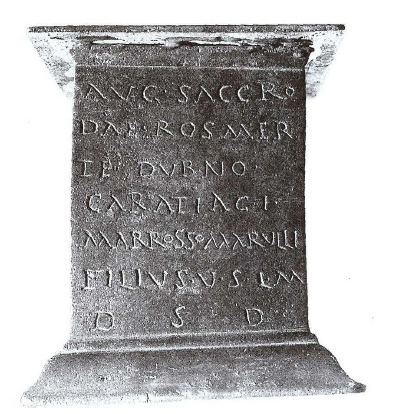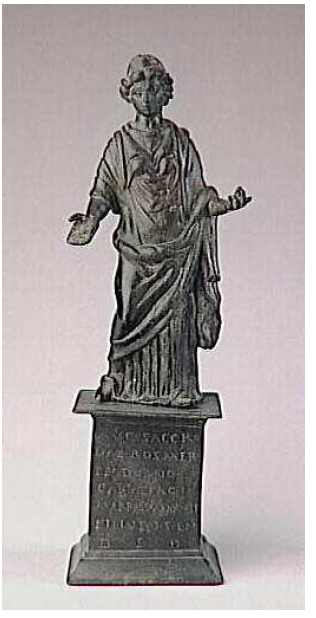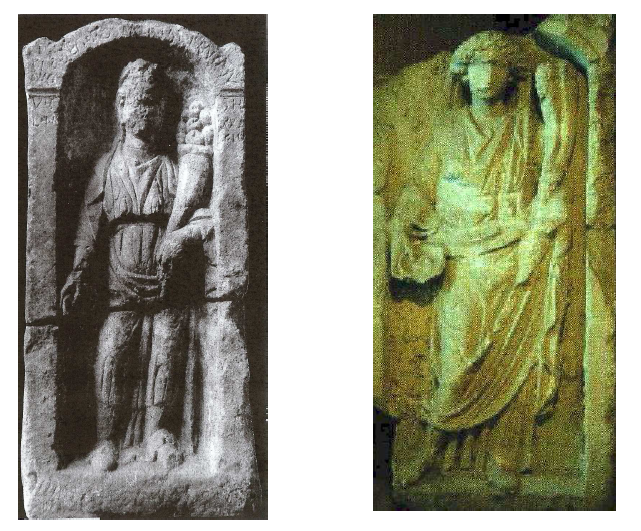3) Iconographical devices combined with an inscription
In addition to those four inscriptions, remarkable images of Rosmerta, combined with a dedication identifying her, are known: the statuette in bronze from Champoulet (Loiret) and the relief* from Escolives-Sainte-Camille (Yonne). In 1935, a hiding-place containing a series of Gallo-Roman bronze statuettes was uncovered in Champoulet, a small village near Saint-Fargeau (Loiret), in the territory of the Carnutes. There was found a bronze statuette of Rosmerta, wearing a coat, a tunic and diadem (fig. 16 and 17).800 René Joffroy suggests she might have held a patera* in her right hand and a caduceus* or cornucopia* in her left hand. The inscription engraved on the pedestal is the following: Aug(usto) saccr(um) d(e)ae Rosmert(a)e Dubnocaratiaci Maross(us) Marulli filius v(otum) s(olvit) l(ibens) m(erito) d(e) s(uo) d(edit), ‘To the Sacred August Goddess Rosmerta Dubnocaratiaci, Marossus son of Marullus paid his vow willingly and deservedly and offered this at his own expense’.801 Interestingly, the dedicator Marossus (maro- ‘great’, ‘big’) and his father Marullus bear Celtic names. Their unique name indicates they are peregrines.802
The substantive Dubnocaratiacius is also attributed to Mercurius and Apollo in three other inscriptions from the same site:803 In h(onorem) d(omus) d(ivinae) deo Merc(urio) Dubnocaratiaco ex stip(endio) eius sub c(ura) Sedati Valloicis ; Aug(usto) sac(rum) Merc(urio) Dubnocaratiaco Messa Marulli v.s.l.m ; Aug(usto) sacr(um) deo Appolino Dunocaratiaco Nobili(s) Titiani f(ilius) v(otum) s(olvit) l(ibens) m(erito).

Dubnocaratiacius could mean something like ‘Dear to the World’, with dubno-, ‘dark’, ‘mysterious’, ‘from the (under)world’ and cara-, ‘dear’,804 but Lejeune and Lambert maintain that Dubnocaratiacius is not to be understood as a divine name but as a localizing epithet in -iaco, referring to a place or domain belonging to somebody.805Like Marti Masuciaco is related to the land owned by Masucius806 and Mars Victor Magniacus Vellaunus to a place called Magniacum,807 Rosmertae Dubnocaratiaci should be interpreted as ‘Rosmerta from the place known as Dubnocaratiacum’, that is ‘the property of Dubnocaratius’. It is actually the proper name of the owner of the domain which means ‘Beloved of the World’.808 In the second inscription to Mercurius it is noticeable that the dedicator Messa, who has a Celtic name, is the daughter of Marullus, and thus the sister of Marossus, the dedicator paying homage to Rosmerta.809 From those inscriptions and bronzes, it can be inferred that the property Dubnocaratiacum belonged to the head of the family Marullus and that a place of worship dedicated to Rosmerta, Mercurius and Apollo was located there. This family is of Celtic origin, for all the members (father, son and daughter) have Gaulish names. Bearing the unique name, they are peregrines.

Another relief* with dedication to Rosmerta, dated from the second half of the 1st c. AD, comes from Escolives-Sainte-Camille (Yonne), in the territory of the Aedui. It was found in a place of worship known as ‘Champ-des-Tombeaux’, a sanctuary located near the spring of the Creusot (fig. 19).810 The goddess is represented standing alone in a niche, wearing the usual long robe and diadem of the Classical mother goddesses. She holds a huge cornucopia*, full of round fruit - possibly apples - in her left hand and a patera* in her right hand. These are the common attributes of the Greco-Roman divinities of abundance and fertility. The inscription, engraved along the arc of the niche, associates Rosmerta with the Emperor: Dea(e) Rosmertae Iunianu(s). // sac(erdos) Aug(ustis) v(otum) s(olvit) l(ibens) m(erito) // S.H. / XXI / TLL (?), ‘To the goddess Rosmerta, Iunianus, priest of Augustus, paid his vow willingly and deservedly’ (fig. 18).811 Originally, the stone was engraved only with the votive formula v.s.l.m. and the price of the stone SH XXI (21 sesterces).812 The dedicator Iunianus is a peregrine*, since he bears the unique name. According to Monique Dondin-Payre, Iunianus is an indigenous Latin name, based on a root iun- signifying ‘desire’, which is typical of peregrines.813 He indicates his function: he is a priest (sacerdos) of the Emperor Augutus. On the account of the formula Dea, the inscription is not prior to the middle of the 2nd c. AD.814
The worship of Rosmerta may be linked to the curative spring of Le Creusot, for excavations carried out at the Champ-des-Tombeaux revealed the foundations of an early 1st-century AD sanctuary and baths. Moreover, anatomical ex-votos* in wood, bronze and stone, similar to those found at the Sources-de-la-Seine, attest to a cult rendered to a healing deity related to the curative spring.815

